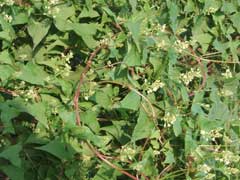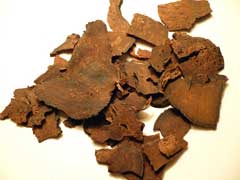 |
|
http://commons.wikimedia.org/wiki/User:Fanghong |
 |
| http://commons.wikimedia.org/wiki/User:Badagnani |
Translate this page:
Summary
Physical Characteristics

 Polygonum multiflorum is a PERENNIAL CLIMBER growing to 4.5 m (14ft 9in).
Polygonum multiflorum is a PERENNIAL CLIMBER growing to 4.5 m (14ft 9in).
See above for USDA hardiness. It is hardy to UK zone 7. It is in flower from September to October, and the seeds ripen from October to November. The species is hermaphrodite (has both male and female organs) and is pollinated by Insects.
Suitable for: light (sandy), medium (loamy) and heavy (clay) soils. Suitable pH: mildly acid, neutral and basic (mildly alkaline) soils. It can grow in semi-shade (light woodland) or no shade. It prefers moist soil.
UK Hardiness Map
US Hardiness Map
Synonyms
Plant Habitats
Woodland Garden Dappled Shade; Shady Edge;
Edible Uses
Edible Parts: Flowers Leaves Root Seed
Edible Uses:
Leaves - raw or cooked. Seed - raw or cooked. It is rather small and fiddly to utilize[105]. Flowers[179]. No more details are given. Root - cooked[2, 177]. It should be washed several times in order to leech out the bitterness[179]. This process will also remove many of the vitamins and minerals from the roots[K]. A famine food, it is only used when all else fails[105].
References More on Edible Uses
Medicinal Uses
Plants For A Future can not take any responsibility for any adverse effects from the use of plants. Always seek advice from a professional before using a plant medicinally.
Antibacterial Anticholesterolemic Antipyretic Antispasmodic Antitumor Astringent Cardiotonic Demulcent
Deobstruent Hypoglycaemic Laxative Sedative Tonic Urinary
He Shou Wu is considered to be one of the most important of the Chinese herbal tonics and is widely used in that country[218]. It is said to restore vitality and virility[174], working especially on the liver and the reproductive, urinary and circulatory systems[238]. Some care should be exercised, however, since excessive doses can cause skin rash and numbness of the extremities[238]. The roots and stems are antibacterial, anticholesterolemic, antispasmodic, astringent, cardiotonic, demulcent, depurative, hypoglycaemic, laxative, sedative, tonic[116, 147, 174, 176, 238, 279]. The roots are taken internally in the treatment of menstrual and menopausal complaints, constipation in the elderly, swollen lymph glands and high cholesterol levels[238]. They are very effective in reducing high cholesterol levels in the blood and increase blood sugar levels[254]. Externally, they are used to treat ringworm, bleeding wounds and sores[238]. The roots are harvested in the autumn, preferably from plants 3 - 4 years old, and are dried for later use[238]. The leaves and roots tonify the liver and kidneys, fortify the blood, strengthen the muscles and prevent premature greying of the hair[218]. The stem is deobstruent and sedative[218]. It is taken internally in the treatment of insomnia and neurasthenia whilst it is applied externally to ringworm[176, 238]. The stems are harvested in late summer or early autumn and are dried for later use[238]. Extracts of the plant have shown antipyretic, antitumour, hypoglycaemic and sedative activity[218].
References More on Medicinal Uses
The Bookshop: Edible Plant Books
Our Latest books on Perennial Plants For Food Forests and Permaculture Gardens in paperback or digital formats.

Edible Tropical Plants
Food Forest Plants for Hotter Conditions: 250+ Plants For Tropical Food Forests & Permaculture Gardens.
More

Edible Temperate Plants
Plants for Your Food Forest: 500 Plants for Temperate Food Forests & Permaculture Gardens.
More

More Books
PFAF have eight books available in paperback and digital formats. Browse the shop for more information.
Shop Now
Other Uses
References More on Other Uses
Cultivation details
Succeeds in an ordinary garden soil[1] but prefers a moisture retentive not too fertile soil in sun or part shade[200]. Repays generous treatment[1]. This species is hardy to at least -15°c[238]. Plants seem to be immune to the predations of rabbits[233]. There is a suggestion that this plant might be dioecious[178], in which case male and female plants will need to be grown if seed is required.
References Carbon Farming Information and Carbon Sequestration Information
Temperature Converter
Type a value in the Celsius field to convert the value to Fahrenheit:
Fahrenheit:
The PFAF Bookshop
Plants For A Future have a number of books available in paperback and digital form. Book titles include Edible Plants, Edible Perennials, Edible Trees,Edible Shrubs, Woodland Gardening, and Temperate Food Forest Plants. Our new book is Food Forest Plants For Hotter Conditions (Tropical and Sub-Tropical).
Shop Now
Plant Propagation
Seed - sow spring in a cold frame. Germination is usually free and easy. When they are large enough to handle, prick the seedlings out into individual pots and plant them out in the summer if they have reached sufficient size. If not, overwinter them in a cold frame and plant them out the following spring after the last expected frosts. Division in spring or autumn. Very easy, larger divisions can be planted out direct into their permanent positions. We have found that it is better to pot up the smaller divisions and grow them on in light shade in a cold frame until they are well established before planting them out in late spring or early summer.
Other Names
If available other names are mentioned here
Native Range
TEMPERATE ASIA: China (Guangdong Sheng, Henan Sheng, Hubei Sheng, Jiangsu Sheng, Jiangxi Sheng, Shaanxi Sheng, Shanxi Sheng, Sichuan Sheng, Yunnan Sheng)
Weed Potential
Right plant wrong place. We are currently updating this section.
Please note that a plant may be invasive in one area but may not in your area so it's worth checking.
Conservation Status
IUCN Red List of Threatened Plants Status :

| Related Plants
|
| Latin Name | Common Name | Habit | Height | Hardiness | Growth | Soil | Shade | Moisture | Edible | Medicinal | Other |
| Polygonum alaskanum | Alaska Wild Rhubarb | Perennial | 1.8 |
-
| | LMH | SN | M | 2 | 1 | |
| Polygonum alpinum | Alpine Knotweed, Alaska wild rhubarb | Perennial | 1.0 |
4-8
| | LMH | SN | M | 2 | 1 | |
| Polygonum amphibium | Willow Grass, Water knotweed, Longroot smartweed, Water smartweed | Perennial | 0.3 |
4-8
| | LMH | SN | WeWa | 1 | 2 | 1 |
| Polygonum arenastrum | Small-Leaved Knotweed, Oval-leaf knotweed | Annual | 0.3 |
4-8
| | LMH | SN | M | 2 | 3 | 1 |
| Polygonum aviculare | Knotweed, Prostrate knotweed | Annual | 0.3 |
4-8
| | LMH | SN | M | 2 | 3 | 1 |
| Polygonum barbatum | Joint Weed | Perennial | 0.8 |
-
| | LMH | SN | M | 1 | 1 | |
| Polygonum bistorta | Bistort, Meadow bistort, Snakeweed | Perennial | 0.5 |
4-7
| F | LMH | SN | MWe | 3 | 3 | 2 |
| Polygonum bistortoides | American Bistort | Perennial | 0.5 |
3-7
| | LMH | SN | M | 3 | 1 | 0 |
| Polygonum bungeanum | Bunge's smartweed | Annual | 0.8 |
0-0
| | LMH | SN | M | 1 | 0 | |
| Polygonum coccineum | Water Smartweed | Perennial | 0.5 |
4-8
| | LMH | SN | WeWa | 1 | 0 | |
| Polygonum conspicuum | | Perennial | 0.6 |
-
| | LMH | SN | M | 1 | 0 | |
| Polygonum convolvulus | Black Bindweed | Annual | 1.2 |
0-0
| | LMH | SN | M | 1 | 0 | 0 |
| Polygonum divaricatum | | Perennial | 1.0 |
-
| | LMH | SN | DM | 1 | 0 | |
| Polygonum douglasii | Knotweed, Douglas' knotweed, Austin knotweed, Engelmann's knotweed, Johnston's knotweed, Large kno | Annual | 0.3 |
0-0
| | LMH | SN | DM | 2 | 0 | |
| Polygonum dumetorum | Climbing false buckwheat | Annual | 1.8 |
0-0
| | LMH | SN | M | 1 | 1 | |
| Polygonum equisetiforme | | Perennial | 1.0 |
7-10
| | LMH | N | DM | 1 | 0 | 2 |
| Polygonum fugax | | Perennial | 0.0 |
-
| | LMH | SN | M | 3 | 0 | |
| Polygonum hydropiper | Smartweed, Marshpepper knotweed | Annual | 0.8 |
0-0
| | LMH | N | WeWa | 2 | 2 | 1 |
| Polygonum japonicum | Japanese Knotweed, Mexican Bamboo, Japanese Knotweed | Perennial | 3.0 |
4-10
| F | LMH | SN | M | 3 | 3 | 3 |
| Polygonum lapathifolium | Curlytop Knotweed | Annual | 0.8 |
4-8
| | LMH | SN | MWe | 1 | 1 | 1 |
| Polygonum limosum | | Perennial | 1.8 |
-
| | LMH | SN | M | 1 | 0 | |
| Polygonum longisetum | Oriental lady's thumb | Annual | 0.5 |
0-0
| | LMH | SN | MWe | 1 | 0 | |
| Polygonum maackianum | | Annual | 0.8 |
-
| | LMH | SN | MWe | 1 | 0 | |
| Polygonum manshuriense | Asian Bistort | Perennial | 0.8 |
-
| | LMH | SN | Mwe | 0 | 1 | |
| Polygonum microcephalum | | Perennial | 0.5 |
-
| | LMH | SN | M | 1 | 0 | |
| Polygonum minus | Pygmy smartweed | Annual | 0.3 |
0-0
| | LMH | SN | MWe | 1 | 0 | |
| Polygonum molle | | Perennial | 2.5 |
6-9
| F | LMH | SN | M | 2 | 1 | 2 |
| Polygonum nepalense | Nepalese smartweed | Annual | 0.3 |
0-0
| | LMH | SN | MWe | 1 | 1 | 1 |
| Polygonum orientale | Prince's Feather, Kiss me over the garden gate | Annual | 1.5 |
0-0
| | LMH | SN | M | 2 | 2 | 0 |
|
|
Growth: S = slow M = medium F = fast. Soil: L = light (sandy) M = medium H = heavy (clay). pH: A = acid N = neutral B = basic (alkaline). Shade: F = full shade S = semi-shade N = no shade. Moisture: D = dry M = Moist We = wet Wa = water.
Now available:
Food Forest Plants for Mediterranean Conditions
350+ Perennial Plants For Mediterranean and Drier Food Forests and Permaculture Gardens.
[Paperback and eBook]
This is the third in Plants For A Future's series of plant guides for food forests tailored to
specific climate zones. Following volumes on temperate and tropical ecosystems, this book focuses
on species suited to Mediterranean conditions—regions with hot, dry summers and cool, wet winters,
often facing the added challenge of climate change.
Read More
Expert comment
Author
Thunb.
Botanical References
74266
Links / References
For a list of references used on this page please go here
Readers comment